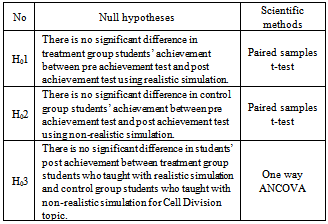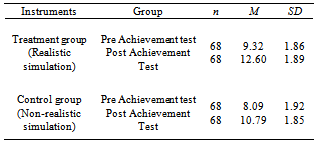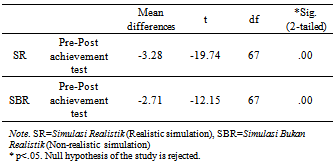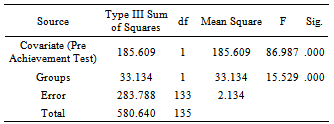-
Paper Information
- Next Paper
- Previous Paper
- Paper Submission
-
Journal Information
- About This Journal
- Editorial Board
- Current Issue
- Archive
- Author Guidelines
- Contact Us
Education
p-ISSN: 2162-9463 e-ISSN: 2162-8467
2013; 3(4): 231-241
doi:10.5923/j.edu.20130304.03
The Effects of Realistic Simulation and Non-Realistic Simulation on Biology Students’ Achievement
Tavasuria Elangovan, Zurida Ismail
School of Educational Studies, Universiti Sains Malaysia, Penang, 11800, Malaysia
Correspondence to: Tavasuria Elangovan, School of Educational Studies, Universiti Sains Malaysia, Penang, 11800, Malaysia.
| Email: |  |
Copyright © 2012 Scientific & Academic Publishing. All Rights Reserved.
Realistic simulation and non-realistic simulation based teaching methods were used to solve Biology learning problems among Form Four Biology students in Malaysia. A sample of 136 Form Four Biology students in Perak, Malaysia from two secondary schools were divided into treatment group (68 students) and control group (68 students) and taught Cell Division topic for three weeks using realistic simulation and non-realistic simulation. Biology classes were randomly selected for this study. First, Biology class randomly chosen as treatment group in which the students were taught with realistic simulation. Meanwhile, second Biology class chosen as control group in which the students were taught with non-realistic simulation. Data of the study were analysed quantitatively using descriptive statistics and inferential statistics such as paired samples t-test and one way ANCOVA Results indicated that realistic simulation is most effective teaching method in Cell Division topic than non-realistic simulation and enhance student’s understandings and achievement in Biology subject.
Keywords: Realistic Simulation, Non-Realistic Simulation, Biology, Cell Division, Form Four Students, Malaysia
Cite this paper: Tavasuria Elangovan, Zurida Ismail, The Effects of Realistic Simulation and Non-Realistic Simulation on Biology Students’ Achievement, Education, Vol. 3 No. 4, 2013, pp. 231-241. doi: 10.5923/j.edu.20130304.03.
Article Outline
1. Introduction
- Biology is a curriculum implemented for two years for Malaysian secondary school students in Form Four (Fourth year) and Form Five (Fifth year). It aims to enable students to understand the concepts of Biology and its application in their daily life style such as solving problems and make right decisions based on learned scientific attitudes and values. It also makes students to understand their responsibility as an environmental manager for universal harmony and well - being of wildlife. This subject provides basic knowledge and skills of Biology education and become as a foundation for the students to further their studies in Biology area and careers related to science and technology[17].
2. Problem Statement
- Few topics such as Cell Division, Photosynthesis, Respiration, and Evolution Food Chain are known to be difficult topics to be learned in Biology[24, 42]. Cell division is one of the Biology topics which students learn during Form Four in Malaysian secondary school. The main learning objective of Cell Division topic is study of chromosomes movement during mitosis and meiosis process. Cell division is a process in which cell divides by mitosis and meiosis. Therefore, mitosis and meiosis are two important concepts in cell division process. Analysis of the Sijil Pelajaran Malaysia (SPM) or Malaysian Certificate of Education examination Biology paper from 2007 to 2011 shows that in Cell Division topic, subtopics such as Cell Cycle, Mitosis and Meiosis are very popular and every year questions regarding these topics were asked in the SPM Biology[12].However, students were unable to answer and still fail in the Biology paper although various strategies have been taken to enhance students’ achievement in Biology[3]. Why do students fail in the Biology paper every year? Apparently, students still fail to understand Biology concepts and they have misconceptions about abstract concepts such as mitosis and meiosis[2-3, 7, 36]. Students still have difficulty in understanding and are confused about the terms related to cell division process. Confusion about the terms leads to students misconceptions about the cell division concept[14, 22]. Most of the teachers claimed that Cell Division topic is one of the most difficult topics in Biology subject[15]. The learning problems in Cell Division faced by students have been attributed to several factors such as less conducive Biology learning environment, lack of effective teaching methods[49] and learning approach that require memorization of abstract concepts[36]. Kiboss[18]emphasized that students’ learning problem in Cell Division topic is caused by science teacher’s expository teaching method which is more focused on teacher-centered learning strategy. Reducing students’ engagement in the learning. Students just listen to the teacher’s explanation, write down the important points and memorize concepts that they had learned. This teacher-centered teaching method gives negative impact on students’ scientific outlook[20]. Teachers should use more innovative and effective teaching methods in teaching and learning process. The effective teaching and learning process should enable all learning goals and objectives to be achieved[45]. The use of various teaching aids and materials in the teaching and learning process make the learning process more interactive, attract students to pay more attention and create a deep curiosity towards the subject that they are learning. Furthermore, teaching aids and materials help students to understand concepts clearly through visualization [53]. Better understandings lead to good academic performance and high achievement among students. Students’ achievement in science and technology subjects including Biology will determine the extent of effectiveness of teaching and learning methods that used by teachers[40]. Therefore, teachers should consider students’ needs in the learning process by selecting effective teaching aids and materials based on students’ ability and level of understanding so as to reduce students’ misconceptions and improve their achievement.Computer simulation is one of the effective teaching methods that facilitate students’ learning in Science[50]. Simulation is an ICT based teaching and learning method. Research findings showed a positive impact on the use of computer simulation in the teaching and learning process[34-35]. Integration of computer simulation in teaching and learning process help students to clearly understand the characteristics of a phenomenon such as how the process of cell division occur through visualization. Lindgren and Schwartz[26] also emphasized that visual based teaching and learning process enhance students’ understandings about learned concepts. Understandings of learned concepts enhance students’ performance and achievement. Cell division process is a complex concept that is difficult to understand if taught with traditional teaching method[2, 4, 14, 22, 43]. However, integration of computer simulations in learning cell division process enhances students’ understandings and achievement on this topic[19]. Therefore, two different forms of 3 dimensional (3D) computer simulations such as realistic simulation and non-realistic simulation were used to teach Cell Division topic in Biology subject for Fourth year (Form Four) students in two different secondary schools in Perak, Malaysia. Realistic simulation is 3D multimedia simulation whereas non-realistic simulation is desktop virtual reality simulation. Teaching and learning through 3D computer simulations either realistic simulation or non-realistic simulation involves visualization which enable students to observe the whole process of cell division while listening to teacher’s explanation. Students can view the program several times and learn the cell division process in the form of visual. This approach will enable them to clearly understand the mechanism of cell division process and to recall the required information in answering biology exam questions. Research findings have shown that realistic simulation and non-realistic simulation are effective teaching and learning method. Realistic simulation and non-realistic simulation are computer based teaching and learning methods which engage students in a virtual learning environment. Virtual learning environment provide real learning environment among students. Realistic simulation enhances students’ understandings about learned Biology concepts and achievement[21]. Teaching method that uses non-realistic simulations also improve students’ performance and achievement[48], students’ understandings and avoid students’ misconceptions[29].
3. Objectives
- The purpose of this study was to identify the effectiveness of realistic simulation and non-realistic simulation on Form Four Biology students’ achievement for Cell Division topic. The study was conducted based on the following objectives: 1. To compare the achievement in the pre-test and post test of the group of students who learn Cell Division topic using realistic simulation. 2. To compare the achievement in the pre-test and post test of students who learn Cell Division topic using non-realistic simulation. 3. To compare the effectiveness of realistic simulation with non-realistic simulation on students’ post test after they had learned the Cell Division topic.
4. Research Questions
- The study aimed to answer the following research questions:1. Is there any difference in students’ achievement be- tween pre- test and post- test after learning Cell Divi- sion using realistic simulation? 2. Is there any difference in students’ achievement between pre-test and post-test after learning Cell Division using non-realistic simulation? 3. Are there any differences in the achievement scores be- tween the group of students taught with realistic sim- ulation and students taught with non-realistic simulation?
5. Research Hypotheses
- Based on the objectives of the study described above, the following null hypotheses have been put forward:H01 There is no significant difference in students’ achievement between pre- test and post-test using re- alistic simulation. H02 There is no significant difference in students’ achievement between pre – test and post - test using non-realistic simulation. H03 There is no significant difference in students’ achievement between students taught with realistic simulation and students taught with non-realistic sim- ulation.
6. Literature Review
- According to Campbell and Reece[6], cell division process is a part of the cell cycle. Cell formed when parent cell divides to become two new cells. Cell division process includes two important processes such as mitosis and meiosis. Mitosis and meiosis is a continuous process[43]. Cell Division topic is one of the important topics in biology and its complex concept most difficult to understand[4, 14, 22, 32, 37]. Study of Atilboz[2]; Aziz and Ami Norliyana[3]; Chattopadhyay[7]; Knippels, Waarlo and Boersma[22]; Lewis, Leach and Wood-Robinson[25]; She and Chen[36]; Ozcan, Yildirim and Ozgur[43] shows that students’ poor understandings and poor mastery level for both mitosis and meiosis concept cause difficulty in understanding of cell division concept among students and make them to have misconceptions about two important concepts of cell division topic such as mitosis and meiosis concepts. Misconceptions about biology abstract concepts affect students’ achievement. Thus, the problem of misconception should be considered in the learning process of an individual[52]. Students have misconceptions and lack of understanding about Cell Division topic due to the use of many educational methods that require memorization of the concepts[36]. Students’ misconception is difficult to replace if teachers use traditional teaching methods alone[52]. Mitosis and meiosis serve as the basis for understanding about the molecular events of mitosis and meiosis which are difficult to observe through the naked eyes. Understanding and construction of the knowledge about mitosis and meiosis concepts at the molecular level depends on the ability of the students’ visualization about the chromosomes movement during mitosis and meiosis[43]. Karamustafaog ˘ lu, Sevim, Mustafaog ˘ lu and C ¸ epni[16] mentioned that students' misconceptions can be reduced or avoided through interactive teaching and learning process that uses educational software program.Computer simulation is one of the educational software programs. Simulation teaching and learning method is based on constructivist learning and support students of different learning styles such as visual, auditory and kinesthetic[13]. Rutten, Van joolingen and Van der veen[41] said that most of the research findings shows that the integration of simulation in traditional teaching methods lead to positive changes in cognitive and affective domains. A study conducted by Gelbart, Brill, and Yarden[9] also shows that computer simulations have a positive influence on learning outcomes when compared with effects of regular teaching method without use of computer simulation for Genetic topics in Biology. Riess and Mischo[39] in their study identified that computer simulation based learning is effective teaching method and have positive impact on Biology students’ understandings and achievements which were analyze through students’ ability in answering questions regarding forest ecosystem topic with correct explanation and their score. Hence, computer simulation based teaching method supports students from different learning styles, create constructivism learning environment in which role of students in learning process is higher than the teachers and enhance students’ understandings, ability of thinking and achievement. Kiboss, Ndirangu, and Wekesa[19] said that simulation can show the dynamic nature of cell division process through animated colored graphics and involve use of various senses. Kiboss, Ndirangu, and Wekesa[19] emphasized that learning environment designed using computer simulation for Cell Division topic in Biology is effective in improving students’ understandings, knowledge and achievement and encourage students to engage actively in the learning process. There are two different forms of 3D computer simulations were used in this study such as realistic simulation and non-realistic simulation to teach Cell Division topic in Biology. Realistic simulation is 3D multimedia simulation which consists of multimedia elements that classify into two categories such as word and pictures. Pictures are presented as illustrations, static pictures, graphics, animation, simulation, photos or videos. Meanwhile, the word is presented in the form of narration and text on the screen[28].Realistic simulation create real learning environment and bring reality to the Biology classroom. Realistic learning environment provide learning experience amongstudents[23]. Lesson Content and the information received in a realistic learning environment, raise motivation among students[1]. Furthermore, study of White, Kahriman, Luberice and Idleh[51] shows that 3D visualization and simulation based teaching method is more efficient compared to traditional teaching methods for learning protein structure concept in Biology. Buckley[5] shows that the simulation and multimedia based teaching method in Biology, promote constructivism learning environment among students and encourage students to develop their own learning goals and increase their concentration toward Biology lesson while interacting with simulation presentation. Buckley[5] in his study use simulations and multimedia resources as Educational model to teach Blood Circulation System topic. Kiboss, Wekesa and Ndirangu[21] said that computer simulation based teaching and learning method for learning Cell Division topic is interactive. Dynamic characteristics of the computer presentation that combines verbal code with graphical representation and animation provides variety of interesting learning activities about the concepts that they have learned, encourage students to interact openly with teaching materials and facilitate students understandings. Combination of graphical representation, animation and simulation in computer simulation based instructions increase the acceptance and understandings of the cell division process that they have learned in the form of illustrations. Study of Kiboss, Wekesa and Ndirangu[21] reported that students taught with computer simulation based instruction got higher achievement than students taught with the traditional teaching method. Teacher centered teaching approach in the traditional teaching method affect students’ Biology achievement. Findings from Kiboss, Wekesa and Ndirangu’s[21] study further strengthen the findings of previous studies that students perform better and score higher when taught with computer based instructional method whereas students who were taught with traditional teaching method unable to perform well[18, 20, 46].Non-realistic simulation is desktop virtual realitysimulation. Application of virtual reality technology in teaching method, create more immersive and interactive virtual learning environment that can be shared by all students in a virtual community. Virtual learning environment help students to solve their learning problems and explore new concepts[38]. Shim, Park, Kim, Kim, Park, and Ryu[44] supports the view of Pan, Cheok, Yang Zhu and Shi[38] that virtual reality is one of latest computer based technology and it increase interactivity. For example, in Biology education, students encouraging to interacting with virtual reality simulations, encouraging student engagement in an interactive learning environment and students can access remotely from any place including long distance place. Virtual reality also creates virtual learning environment that uses various senses, more immersive than other computer based teaching and learning methods and has a significant impacts on students’ learning.Virtual reality technology in education improves student’s motivation and understandings. It is effective in teaching difficult topics and experiments that are difficult to understand if teach with traditional teaching method. This is because, virtual reality learning environment promote self directed learning and the virtual reality based 'hands-on' activities assist students in understanding of scientific abstract concepts[44]. Furthermore, Shim, Park, Kim, Kim, Park, and Ryu[44] reported that students show more interest in virtual reality simulations than teaching methods that use multimedia and students assume that virtual reality simulations are very helpful in learning science subjects especially Biology. Findings of Shim, Park, Kim, Kim, Park, and Ryu[44] study shows that treatment group students who taught eye structure and function concept with 3D virtual reality simulation score higher marks in post test than control group students who taught with 2D media. Hence, 3D virtual reality simulation is effective teaching method in enhancing students’ understandings. In another study, Varma and Linn[48] examine the use of interactive technology to support students’ understandings of the greenhouse effect and global warming in Biology. Varma and Linn[48] reported that, student’s understandings increase after they conduct experiments using virtual visualization. The results showed that students’ knowledge and understandings increase when students are actively involved in the learning process. Students’ achievement shows that there was an increase in their post test scores than the pre test scores. Study of Meir, Perry, Stal, Maruca and Klopfer[29] also reported that there was an increase in students’ understandings and reduce students’misconceptions when students conduct experiments to learn about diffusion and osmosis concept in the virtual laboratory named as 'OsmoBeaker'. Meir, Perry, Stal, Maruca and Klopfer[29] concluded that the virtual simulation based learning environment enhance learning among students.Mikropoulos, Katsikis, Nikolou and Tsakalis[25]conducted a study about the teaching of Plant Cell Biology topic and Photosynthesis topic using virtual reality technology that developed by virtual reality technology software known as 'Superscape'. All trainee teachers who involve in the study recognize that virtual reality is a powerful educational tool, encouraging students to actively and creatively engage in learning process, supports visualization of complex phenomena and elements that difficult to observe without confused with real objects and situations. All trainee teachers assume that virtual reality learning environment is effective in knowledge construction and they said that virtual reality does not a realistic learning environment.
7. Pilot Study
- A pilot study was conducted to check the reliability and validity of actual research instruments such as the post achievement test questions. First, the validity of the actual research instruments was determined. This is to ensure that the validity of test fulfills the goal or objective of the test was constructed. Set of questions that have been prepared for the posttest achievement was given to experts in science education to determine the validity of the questions that were constructed. The test was validated by two different teachers from two schools in Perak who have more than five years of experience in the field of Biology Education to ensure that the prepared items were appropriate for student thinking level and ability, comprise correct Biology terms and the sentences are easy to understand and not misleading to students. Both teachers also suggested to drop or modify the questions based on From Four Biology Syllabus if any Biology question misleading. After correction, the post achievement test was given to an English teacher for verification in terms of language and clarity of purpose so that the translation does not change the real meaning of the questions. Second, reliability of the actual research instruments was identified. Reliability means the stability or consistency of a measurement[11]. Noraini[33] said that Cronbach alpha was used to analyze the scaled instruments such as the Likert - type scales, Thurstone, Guttman and Semantic Differential. Meanwhile, the Kuder-Richardson Formula 20/21 method is use to analyze the instrument that consists of dichotomous items. Therefore, the reliability of the post achievement test used in this study was analyzed by using Kuder-Richardson Formula 20 (K-R 20) method. Lyles[27]; Gliner and Morgan[10]; Menard[30] said that an alpha value is good if it exceeds 0.60. Post achievement test was tested on 61 Form Four Biology students who were randomly selected from two secondary schools in Perak. Respondents that selected for pilot study are not actual respondents. Pilot study was conducted to get feedback in terms of possible weaknesses about the developed instrument such as post achievement test and to see whether students can understand those items or not. The students were given 20 minutes to complete the post achievement test about Cell Division topic. After that, the pilot study data were analyzed to identify the index of discrimination (ID) and the difficulty index (CI) for the post achievement test and modifications were made to the parts required. Thomas, Nelson and Silverman[47] said that an instrument items that have the ID more than 0.2 but less than 1.00 is a good item and acceptable. Items that have the ID value less than 0 known to be as negative items that are not good and not acceptable. Items that have a negative ID values should be discarded. In addition, the alpha reliability coefficient is determined by using Kuder-Richardson Formula 20 (K-R 20) method for post achievement test as shown in Table 1:
|
8. Methodology
8.1. Study Design
- The present study was a quasi-experimental study. The present study was done by dividing the sample into two groups: control group and the treatment group. Biology classes from two secondary schools from Perak, Malaysia were randomly selected. Students from the first Biology class were assigned as the treatment group while students from the second Biology class was assigned as the control group. Both groups each comprise of 68 Biology students. The control group was taught with non-realistic simulation whereas the treatment group was taught with realistic simulation for Cell Division topic. Quasi-experimental design is a quantitative approach because it involves measurement and has two variables such as dependent variable and independent variable. The dependent variable is Biology students’ achievement and the independent variables are realistic simulation based teaching method and non-realistic simulation based teaching method. Measurement is carried out through a set of pre-post achievement test questions. Pre achievement test and post achievement test consisted of 18 objective questions. Before control group and treatment group students followed the Cell Division topic lesson using realistic simulation and non-realistic simulation, pre achievement test was given to both control group and treatment group students. After that, the control group was taught using non-realistic simulation whereas the treatment group was taught using a realistic simulation. Post achievement test was given to both control group and the treatment group after they finished learning the Cell Division topic for three weeks. The design of the present study is summarized in Figure. 1:
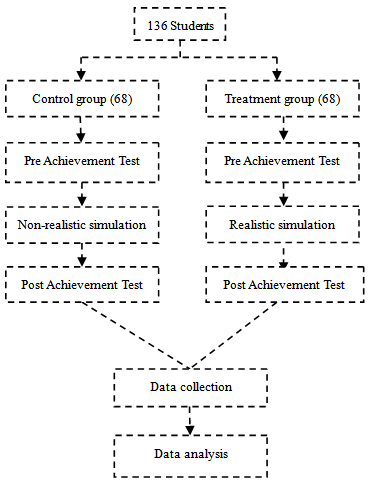 | Figure 1. Design of the present study |
8.2. Materials
- Realistic simulation and non-realistic simulation were selected from existing software on the website which is freely accessible. Both realistic simulation (3D multimedia simulation) and non-realistic simulation (desktop virtual reality simulation) are 3D simulations. Both realistic simulation and non-realistic simulation are consisting of four main concepts of Cell Division topic such as cell cycle, mitosis, meiosis I and meiosis II. Realistic simulation can be played in any video software like RealPlayer, Window Media Player and VLC Media Player. Meanwhile, non-realistic simulation can be played in a computer desktop if the computer has installed 3D software such as Cortona 3D, Cosmo Player Setup and so on. Snapshots of realistic simulation and non-realistic simulation about the Cell Division topic are shown in Figure 2:
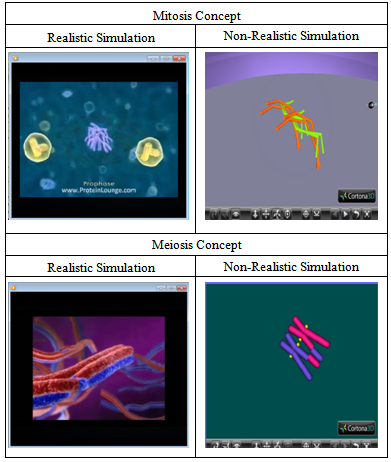 | Figure 2. Snapshot of realistic simulation and non-realistic simulation for mitosis and meiosis concept in cell Division topic |
8.3. Data Analysis
- Preliminary analyses have been conducted before use one way ANCOVA method for null hypotheses testing to ensure that there was no error in the data file and to ensure the basic assumptions of ANCOVA were not violated. The basic assumptions of ANCOVA such as the normality of the distribution of data in each scale, linearity, homogeneity of regression slopes and homogeneity of variances were checked and ensure that there was no violation of these basic assumptions for conducting one way ANCOVA. Pre achievement test data was analyzed followed by post achievement test data in the preliminary analysis. The pre achievement test scores were used as a covariate to adjust and control the effects of covariate (students’ pre achievement) on the dependent variable (students’ post achievement). All pre achievement test and post achievement test data were analyzed using SPSS 16.0 software. Descriptive statistics was used to describe the characteristics of the variables that used in a study and it used to make inferences based on the numerical data whereas inferential statistics used to describe the relationship between the variables[8]. Descriptive statistics that used in present study were the number of people, percentage, the percentage difference, frequency, mean, and the mean difference. Inferential statistics that used in present study were paired samples t-test and one way ANCOVA. Inferential statistics and descriptive statistics used to identify the effectiveness of two types of teaching methods such as realistic simulation and non-realistic simulation on students’ achievement for Cell Division topic. In inferential statistics such as paired samples t-test and one way ANCOVA, the significance level must be set at level (p <0.05). If the value of p <0.05, then the results obtained said to be reliable by 95% and the null hypothesis will be rejected. Table 2 shows the type of scientific analysis method used for each hypothesis of the present study.
|
9. Results
- 136 Form Four Biology students from two secondary schools in Perak state, Malaysia were involved in this study. Biology classes were randomly selected for this study. First Biology class was selected as a treatment group. Meanwhile, the second Biology class is selected as a control group. Table 3 shows distribution of students into control group and the treatment group.
|
|
|
|
10. Discussion
- Based on the descriptive statistics, both control group and treatment group got higher scores in post achievement test than pre achievement test. However, treatment group students who taught with realistic simulation have gained a mean score in post achievement test than the control group students who taught Cell Division topic using non-realistic simulation. The mean score differences between treatment group and control group for post achievement test is 1.81. These results show that realistic simulation is more effective teaching method than non-realistic simulation for Cell Division topic. Based on the inferential statistics such as paired samples t-test and one way ANCOVA results, all the three null hypotheses were rejected. Analysis of all three null hypotheses was described as follows: H01 There is no significant difference in treatment group students’ achievement between pre achievement test and post achievement test using realistic simulation. Paired samples t-test was used to identify the effectiveness of realistic simulations on treatment group students’ achievement for Cell Division topic. Paired samples t-test showed that there were significant differences in achievement between pre achievement test and post achievement test of treatment group students who taught with realistic simulation. Table 4 and Table 5 shows that the treatment group had significantly gained mean scores in post achievement test (M = 12.60, SD = 1.89) than pre achievement test (M = 9:32, SD = 1.86), t(67) = -19.74; p <.001 (two-tailed). Thus, the first null hypothesis of the present study is rejected. Figure 3 reveals about the descriptive statistics results for the treatment group that their mean scores have increased by 3.28 in post achievement test than pre achievement test. These results indicate that realistic simulation teaching method in Cell Division topic enhance treatment group students’ understandings and improve their performance in Biology.
 | Figure 3. Difference in treatment group students’ achievement between pre achievement test and post achievement test |
 | Figure 4. Difference in control group students’ achievement between pre achievement test and post achievement test |
 | Figure 5. Difference in estimated marginal mean scores between treatment group and control group students for post achievement test |
11. Conclusions and Perspectives
- In conclusion, teaching methods that use realistic simulations and non-realistic simulations have positive impacts on Biology. The result of the present study indicates that realistic simulation is the most effective Biology teaching method than non-realistic simulation. Further in the present study, it was found that integration of realistic simulation in Cell Division topic helps students to visualize the abstract concepts to clearly understand how the process takes place and avoid misconception. Students more understand if they learn abstract concepts through observation. It is evident from these results that Biology students’ achievement can be improve if teachers continuously use realistic simulation in the teaching and learning process. There are some recommendations for the improvements in the future study. Future study should not limit to three weeks of time period and should conduct the realistic simulation and non-realistic simulation based teaching and learning process for more than five weeks to see the long term positive impacts of realistic simulation and non-realistic simulation in several difficult topics of Biology. Next, should compare the effectiveness of small group of learning with large group of learning which should consider other factors that might affect students’ achievement such as gender differences, students’ ability level and spatial level. Furthermore, computers should provide to every student or three students in a group sharing one computer during teaching and learning process to encourage students explore and learn by their own. Future study should carry out using both quantitative and qualitative research methods to justify.
ACKNOWLEDGEMENTS
- I thank my supervisor Prof. Dr. Zurida Ismail (School of Educational Studies, Universiti Sains Malaysia) who supports and guide me for my master research and for reading the manuscript. Then, I would like to thank Universiti Sains Malaysia for providing me fellowship as a financial assistance to support my master studies.
 Abstract
Abstract Reference
Reference Full-Text PDF
Full-Text PDF Full-text HTML
Full-text HTML
